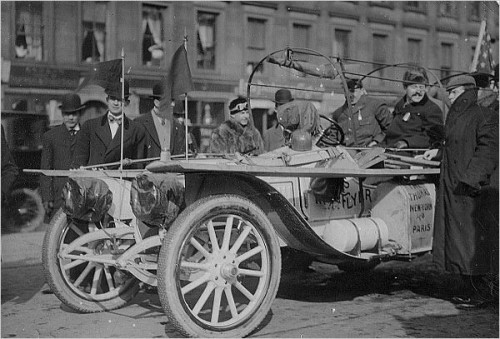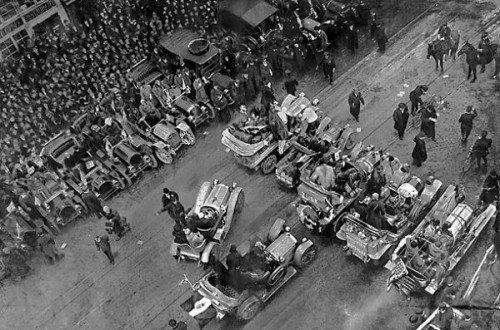From Smithsonian Magazine:
A crowd of 250,000 jammed Times Square to see the start of the race.
Nascar is a multibillion-dollar business whose history and rich mythology are rooted in money; Southern liquor-runners and moonshiners gave the earliest, postwar version of the sport much of its tone. But long before the advent of stock-car racing, competitive drivers cared less about prize or profit than about simply completing the course. The men who lined up in the swirling snow of Times Square on the morning of February 12, 1908, were embarking on a nearly unimaginable feat: a race from New York to Paris, westward. The contest was sponsored not by Bank of America or Coors Light, but by the French newspaper
Le Matin and the
New York Times. The prize: a 1,400-pound trophy and proving it could be done.
The proposed route would take the drivers across the United States, including through areas with very few paved roads, and then head north through Canada. Next came a left turn at Alaska, which the drivers had to cross in order to arrive at the
Bering Strait, which separated the American wilderness from the Russian one. The race’s organizers started it in the middle of winter in the hope that the strait would be frozen. The course then led through Siberia, which no one had traveled by car, before heading into the final stretch: Moscow, St. Petersburg, Berlin and Paris—overall, a 22,000-mile trek in an age when the horse was considered more reliable than the horseless carriage. The New York-to-Paris race was suppoed to be (and is still largely considered) the greatest of them all, even surpassing the prior year’s
Peking-to-Paris competition, in which the winner, Italian Prince
Scipione Borghese, enlisted donkeys and mules to pull his car and sipped oily water from its radiator to relieve his thirst. His reward was a magnum of champagne.
In Times Square that morning 17 men, including drivers, mechanics and journalists, crammed into six cars from four countries: three from France, and one each from Germany, Italy and the United States. A quarter of a million people lined Broadway up to northernmost Harlem; those who couldn’t glimpse the cars had to settle for the whiff of gasoline and the strains of a brass band. The American entry, a 60-horsepower touring car called the Thomas Flyer, carried three extra gasoline tanks with a capacity of 125 gallons and primitive canvas convertible top. The race was scheduled to begin at 11 a.m., when
Mayor George B. McClellan Jr., son of the Union Civil War general, planned to fire the starting pistol, but he was characteristically late. At a quarter-past, railroad financier Colgate Hoyt snatched the golden gun from the table and shot it into the air.
The contestants represented an
international roster of personalities. G. Bourcier de St. Chaffray, driving the French De Dion, once organized a motorboat race from Marseille to Algiers that resulted in every single boat sinking in the Mediterranean. His captain was Hans Hendrick Hansen, a swashbuckling Norwegian who claimed to have sailed a Viking ship, solo, to the North Pole. He declared that he and his companions would reach Paris or “our bodies will be found inside the car.” Frenchman Charles Godard, driving the Moto-Bloc, participated in the Peking-to-Paris race without having driven a car and set an endurance record by driving singlehandedly for 24 hours nonstop.
Emilio Sirtori, the driver for the Italian Zust, took with him 21-year-old journalist and poet Antonio Scarfoglio, who had threatened to pilot a motorboat across the Atlantic if his father didn’t let him enter the race. (His father, a prominent newspaper editor in Naples, relented.) The German entrant, driving the Protos, was an aristocratic army officer named Hans Koeppen who regarded the race as an opportunity to raise his rank from lieutenant to captain. Montague “Monty” Roberts, manning the Thomas Flyer, was a gregarious crowd favorite and one of few American drivers who actually trained for races. His teammate was George Schuster, a 35-year-old mechanic for the
E. R. Thomas Motor Company in Buffalo, New York. One of 21 children born to Casper Schuster, a German immigrant who worked as a blacksmith, George was an expert radiator solderer, chassis inspector, motor tuner and test driver. To Roberts, he was an ideal choice—high enough in the factory hierarchy to be considered indispensable, but too low to steal attention from Roberts himself. After the starting shot, the cars moved forward, Scarfoglio wrote, “between two thick hedges of extended hands amidst a roar as of a falling torrent.” The poet blew a kiss to the crowd, and they were off.
August Pons, driver of the French Sizaire-Naudin, drpopped out after only 96 miles with a broken differential. The De Dion, the Zust and the Thomas Flyer quickly emerged as the leaders, with the Protos and the Moto-Bloc bringing up the rear. In Hudson, New York, the cars plowed through foot-deep snow in a single file. Schuster circled the Thomas Flyer—which had no heater or windshield—with a stick to check snow depth and put down planks for traction. The trail out of Auburn, which the
New York Times described as the worst road in the United States, lived up to its reputation, with the three leading cars getting mired at Dismal Hollow in the Montezuma Swamp. The men prepared to camp for the night, but an American guide hired by the Italians came with six horses to pull the cars through......
MORE
 The American team was headed by Monty Roberts and George Schuster, in the Thomas Flyer. From http://www.sportscardigest.com/.August Pons, driver of the French Sizaire-Naudin, drpopped out after only 96 miles with a broken differential. The De Dion, the Zust and the Thomas Flyer quickly emerged as the leaders, with the Protos and the Moto-Bloc bringing up the rear. In Hudson, New York, the cars plowed through foot-deep snow in a single file. Schuster circled the Thomas Flyer—which had no heater or windshield—with a stick to check snow depth and put down planks for traction. The trail out of Auburn, which the New York Times described as the worst road in the United States, lived up to its reputation, with the three leading cars getting mired at Dismal Hollow in the Montezuma Swamp. The men prepared to camp for the night, but an American guide hired by the Italians came with six horses to pull the cars through......MORE
The American team was headed by Monty Roberts and George Schuster, in the Thomas Flyer. From http://www.sportscardigest.com/.August Pons, driver of the French Sizaire-Naudin, drpopped out after only 96 miles with a broken differential. The De Dion, the Zust and the Thomas Flyer quickly emerged as the leaders, with the Protos and the Moto-Bloc bringing up the rear. In Hudson, New York, the cars plowed through foot-deep snow in a single file. Schuster circled the Thomas Flyer—which had no heater or windshield—with a stick to check snow depth and put down planks for traction. The trail out of Auburn, which the New York Times described as the worst road in the United States, lived up to its reputation, with the three leading cars getting mired at Dismal Hollow in the Montezuma Swamp. The men prepared to camp for the night, but an American guide hired by the Italians came with six horses to pull the cars through......MORE